Abstract
1. Stretch of voluntarily activated human muscle results in a reflex response consisting of short-latency (M1) and delayed long-latency (M2) components. The mechanism of the M2 response remains the subject of controversy. The present study tested the universality of the hypothesis that the M2 response results from the transmission of low-threshold muscle afferent input travelling over a long-loop supraspinal pathway. Muscle reflex responses resulting from imposed stretch were obtained from the first dorsal interosseus (FDI), biceps brachii (BB), triceps brachii (TB) and triceps surae (TS) muscles. 2. Patients suffering from Huntington's disease (HD) show a selective loss of FDI-M2 responses, with sparing of the M1. This has been attributed to disruption of supraspinal pathways as a part of the disease pathology. Accordingly, HD has been used in the present study as a model to test the universality of the long-loop hypothesis: if this is so, then HD patients with an absent FDI M2 should also fail to show an M2 response in other muscles. 3. It is shown that a group of HD patients in whom the FDI-M2 response was absent or residual developed clear M2 responses in the TB, BB and TS muscles following stretch sufficient to invariably evoke this component in normal subjects. 4. It is thus concluded that longer-latency stretch reflex components are not invariably mediated over long-loop supraspinal pathways, but that this mode of control is dominant only in muscles, such as those of the hand, whose function depends largely on direct cortical control.
Full text
PDF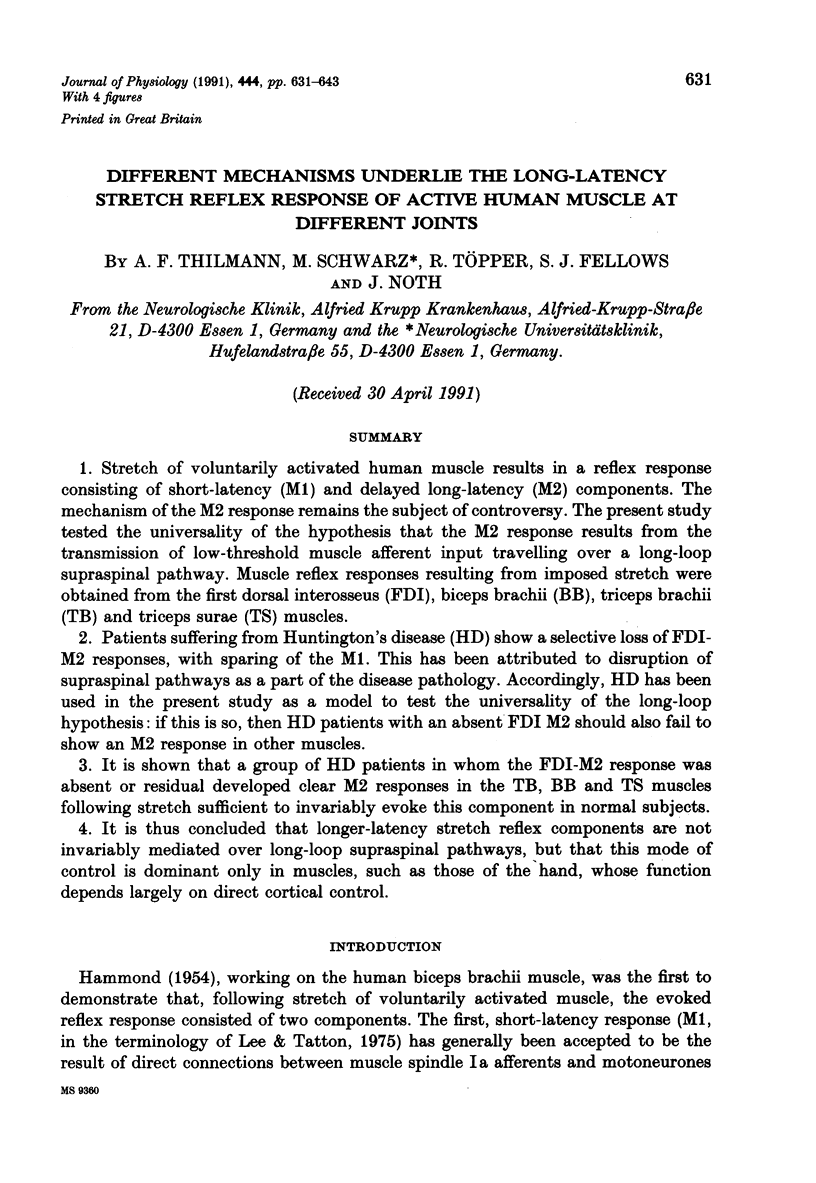

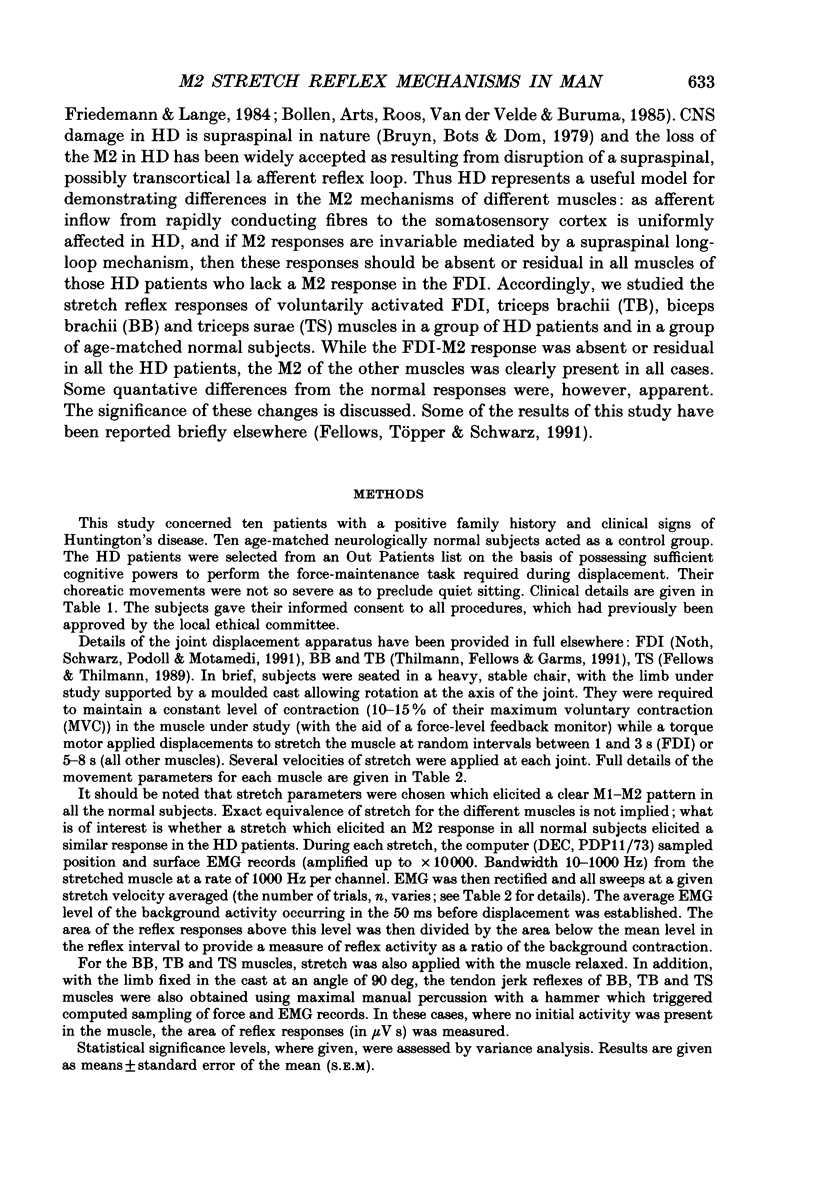
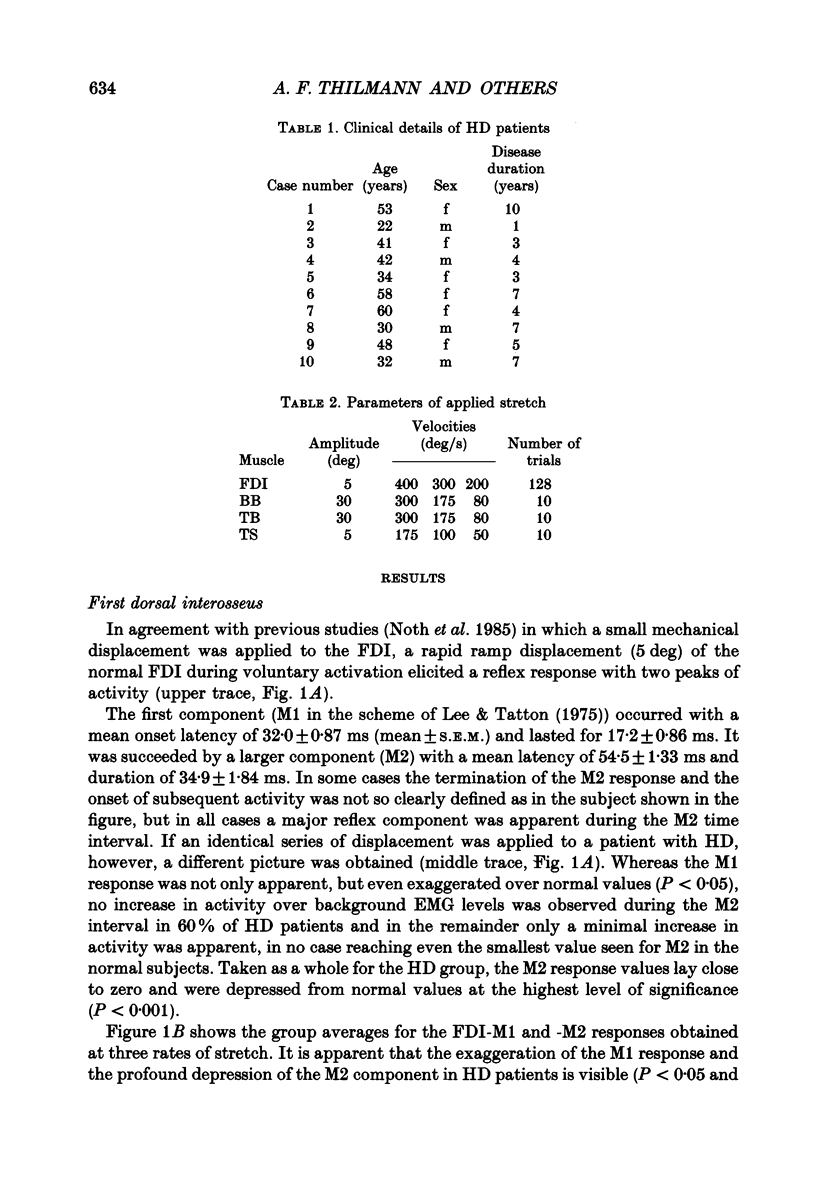
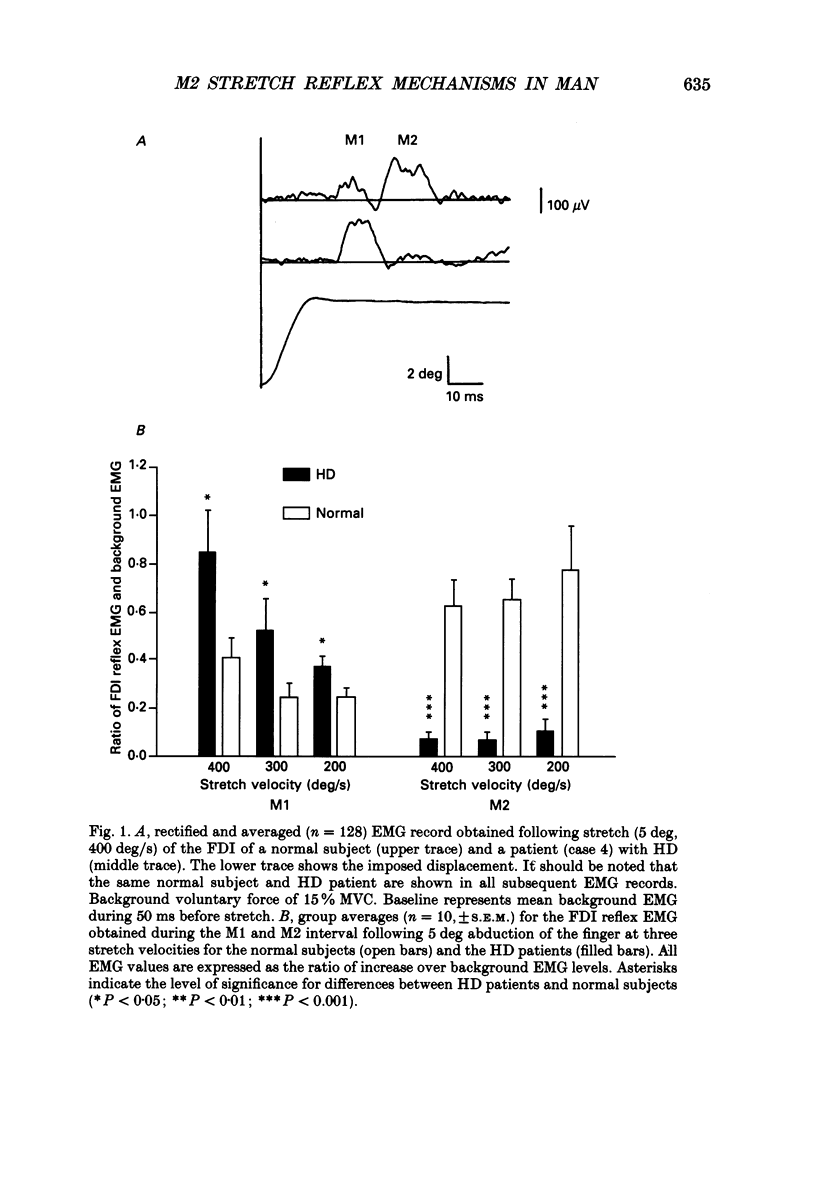
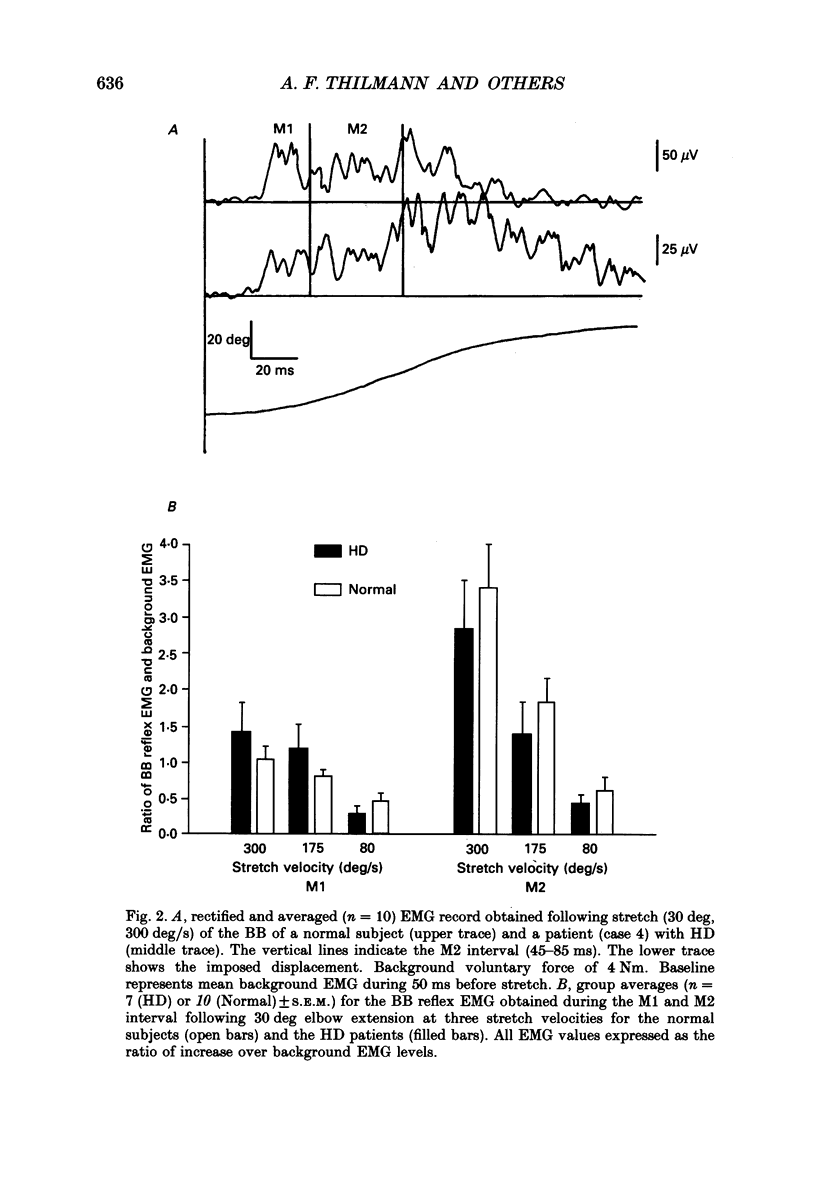
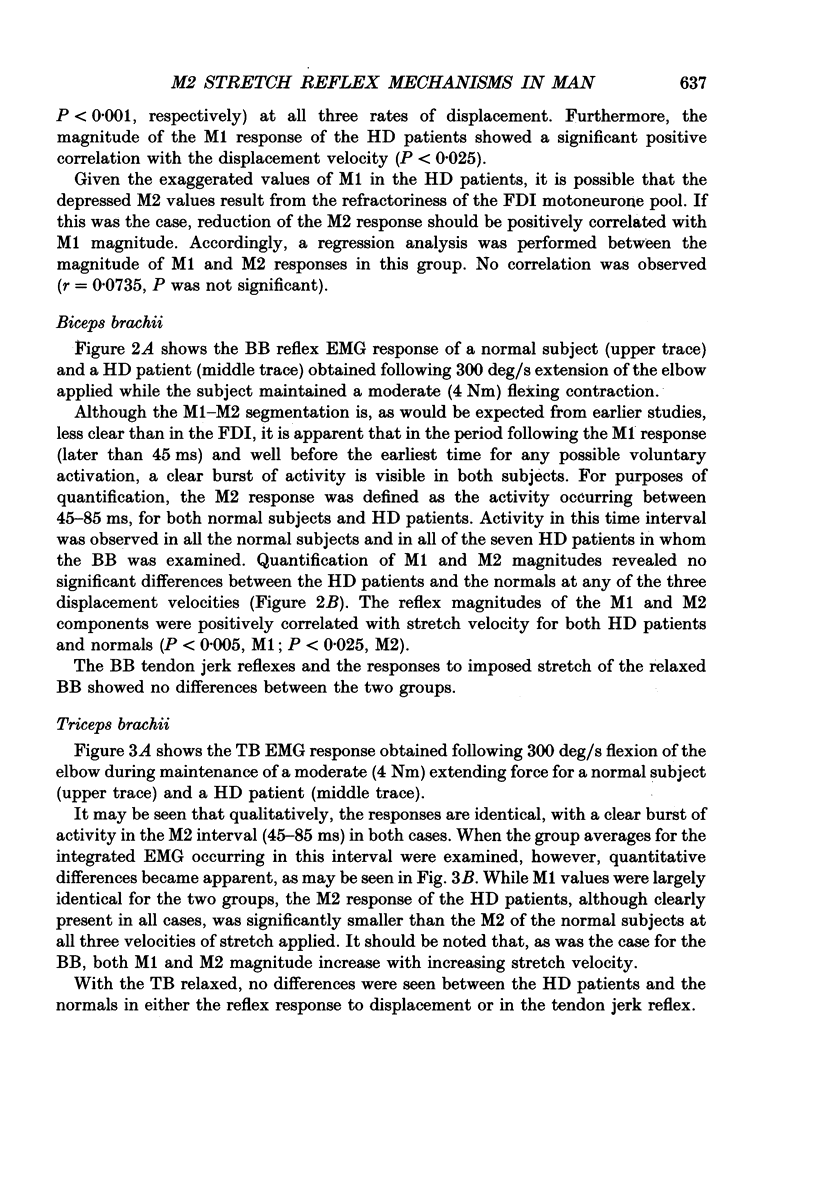
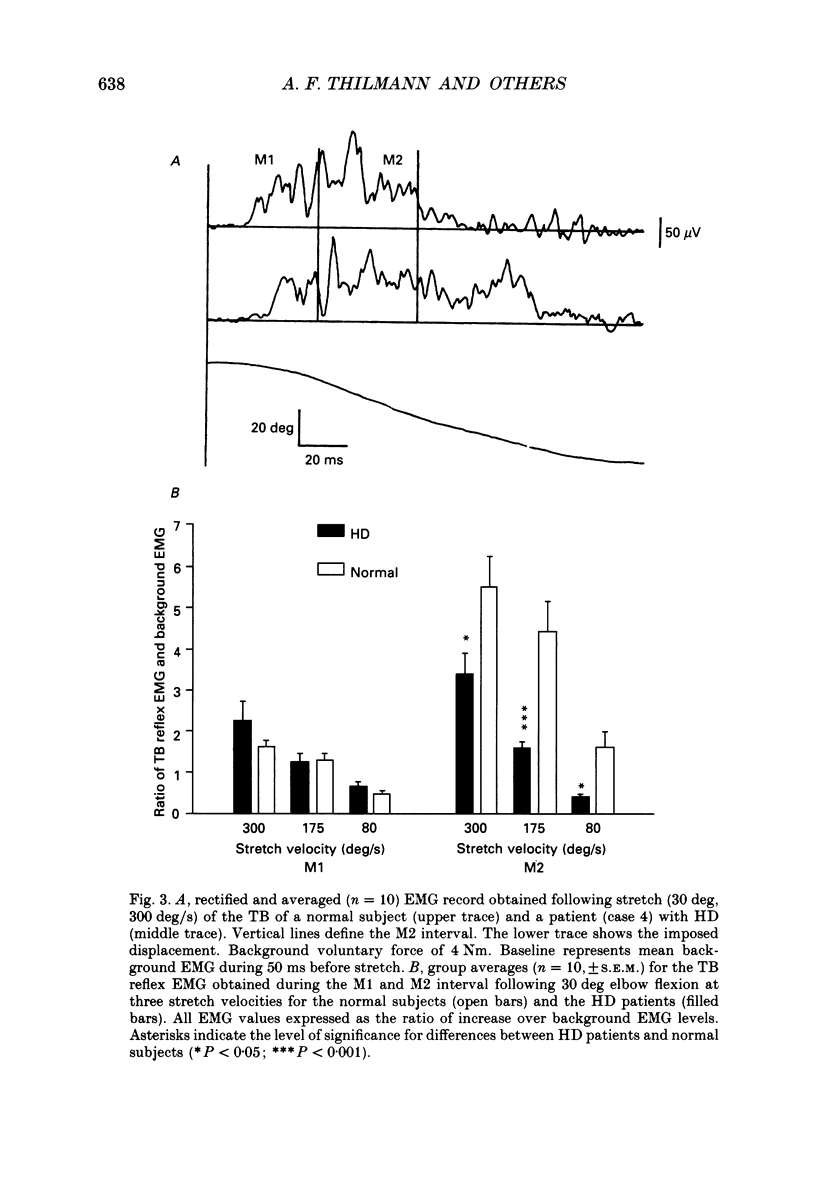
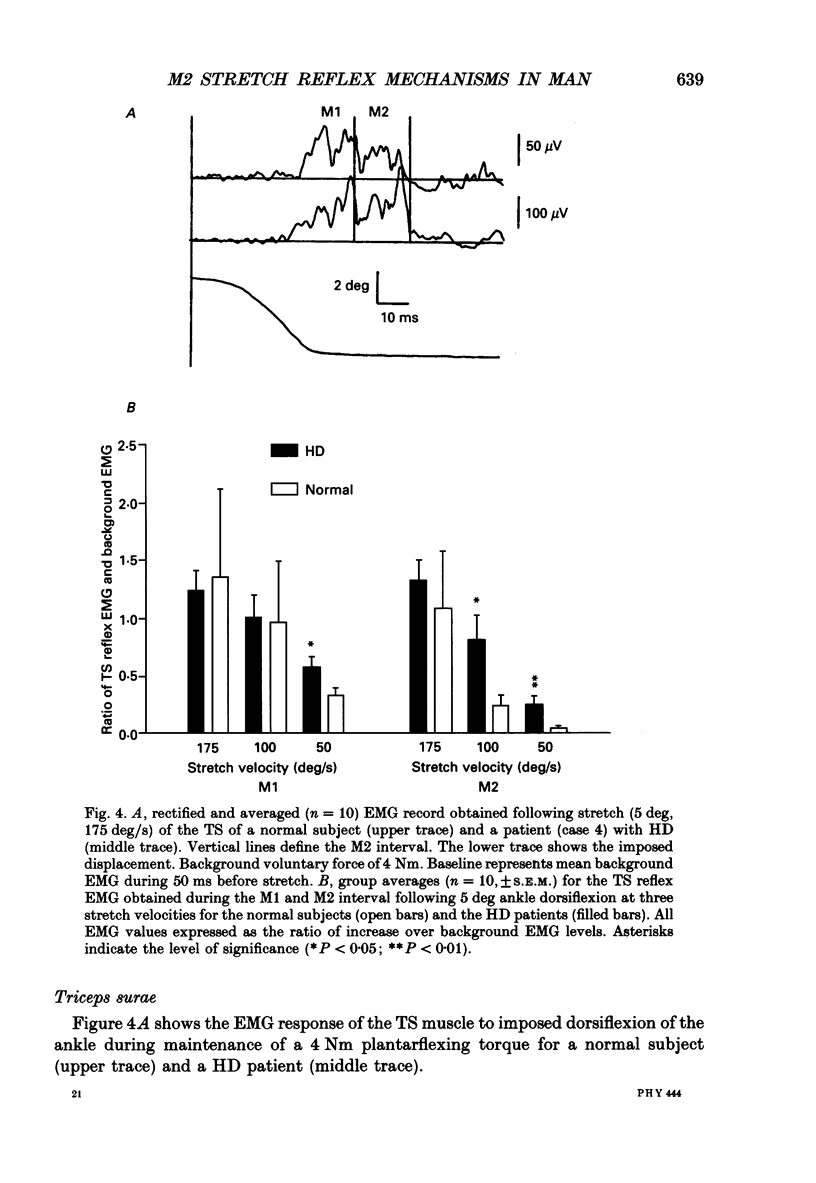
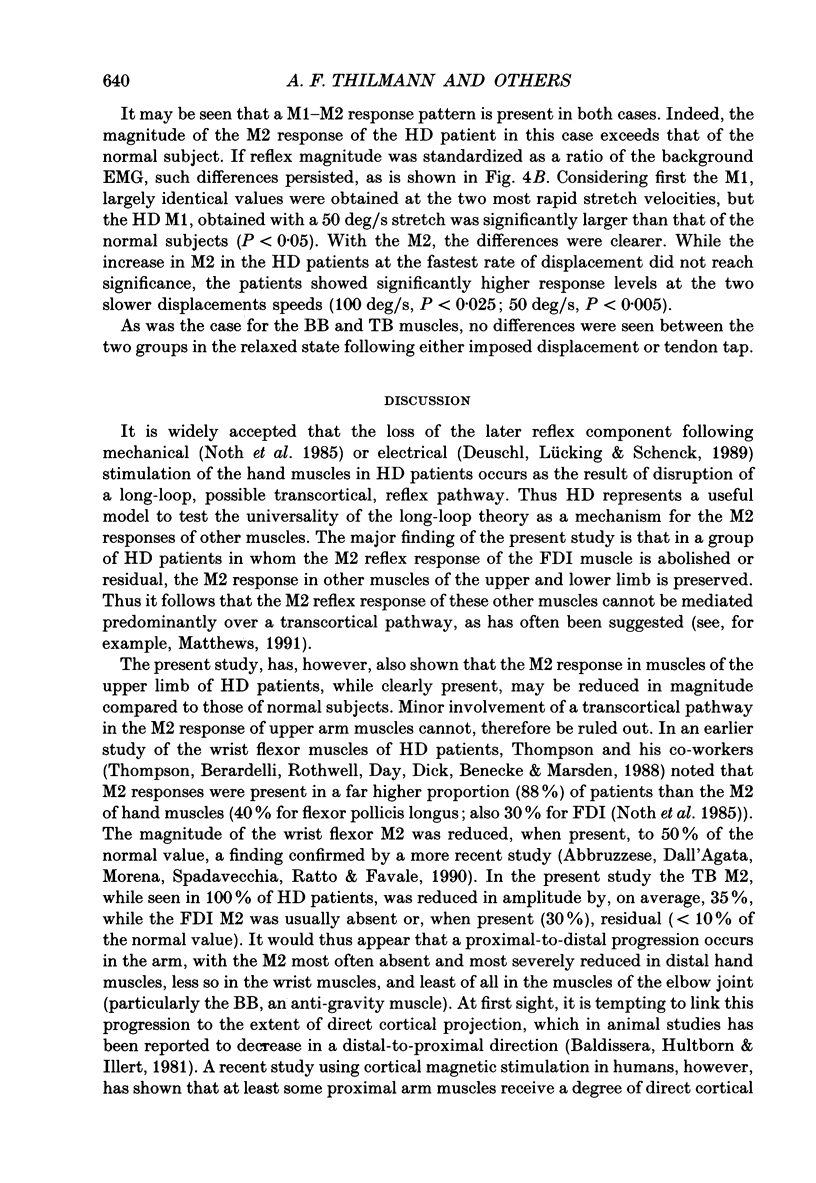
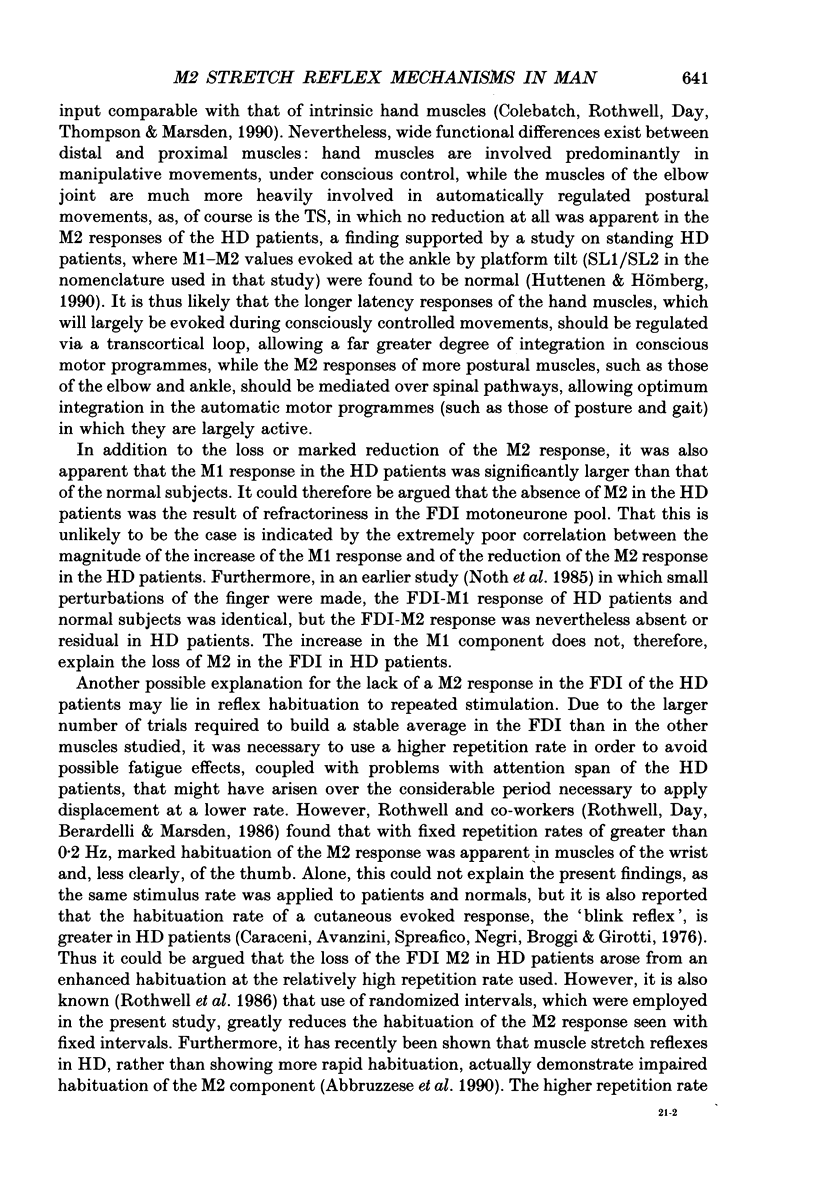
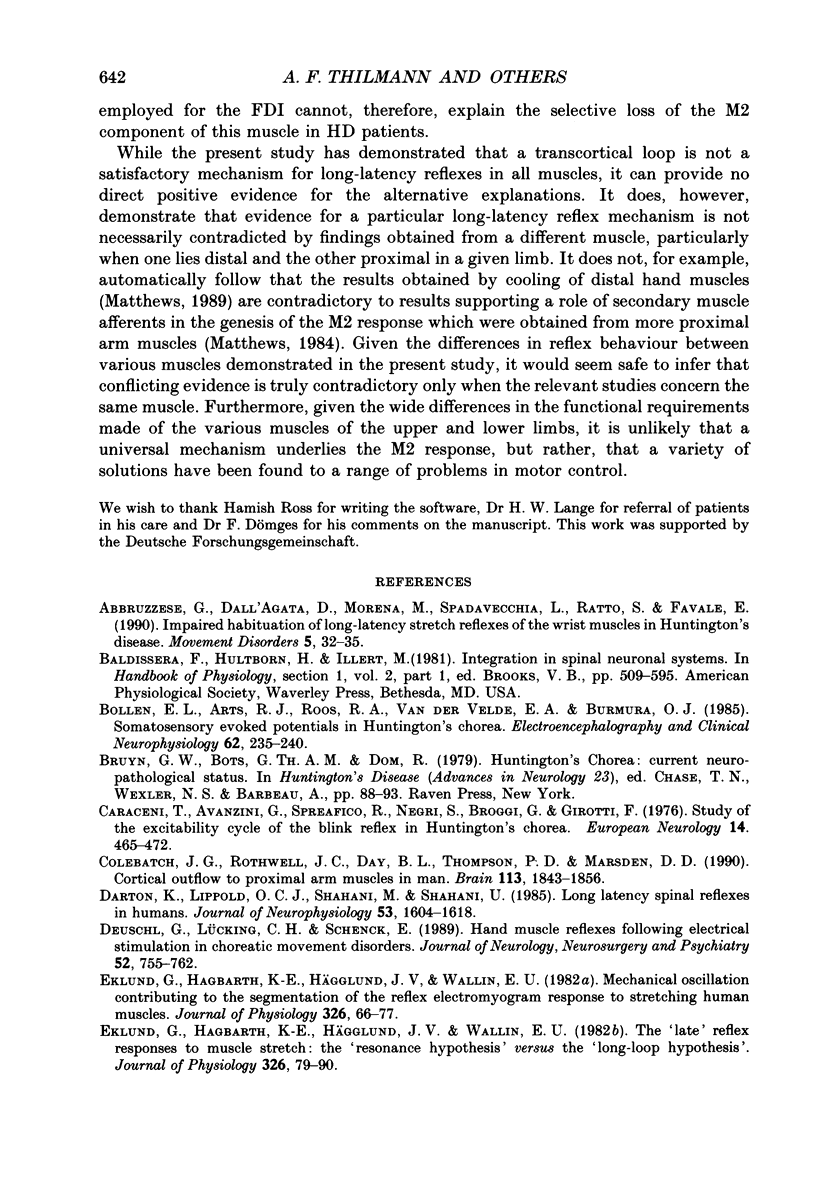
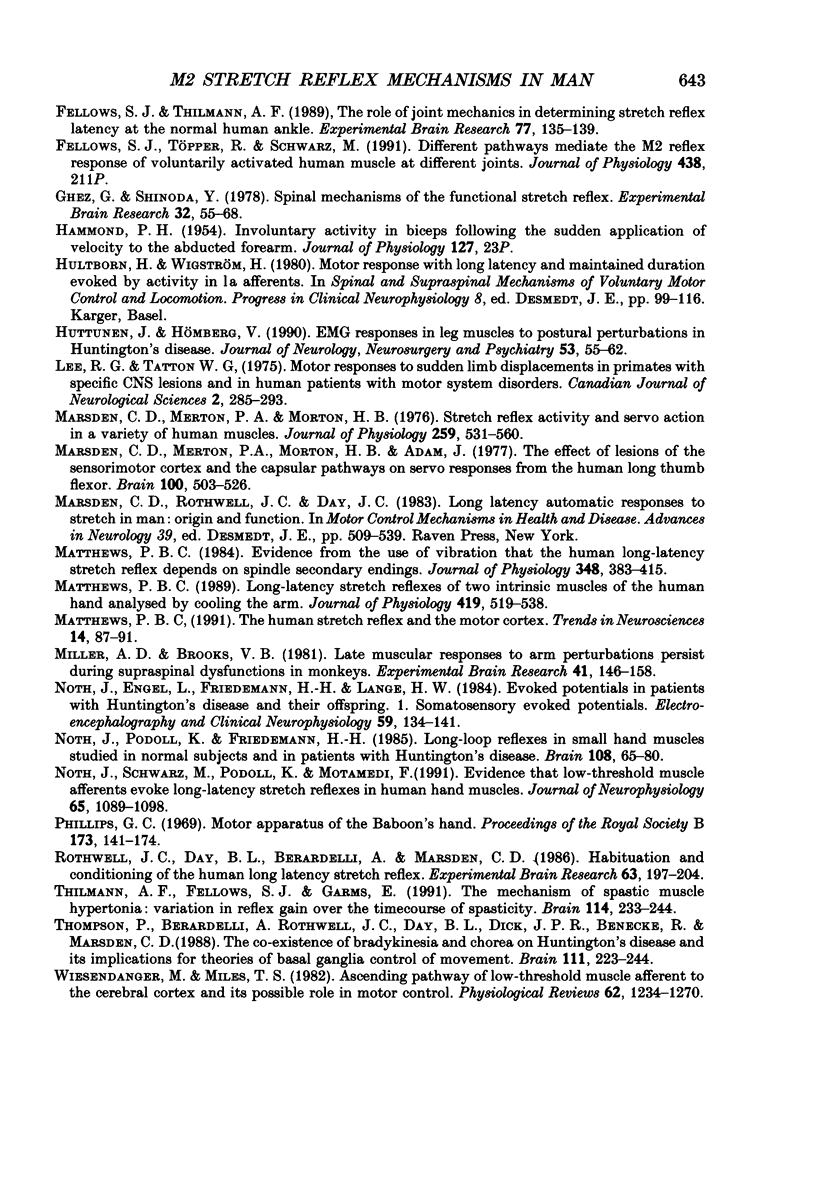
Selected References
These references are in PubMed. This may not be the complete list of references from this article.
- Abbruzzese G., Dall'Agata D., Morena M., Spadavecchia L., Ratto S., Favale E. Impaired habituation of long-latency stretch reflexes of the wrist muscles in Huntington's disease. Mov Disord. 1990;5(1):32–35. doi: 10.1002/mds.870050108. [DOI] [PubMed] [Google Scholar]
- Bollen E. L., Arts R. J., Roos R. A., Van der Velde E. A., Buruma O. J. Somatosensory evoked potentials in Huntington's chorea. Electroencephalogr Clin Neurophysiol. 1985 Jul;62(4):235–240. doi: 10.1016/0168-5597(85)90001-2. [DOI] [PubMed] [Google Scholar]
- Caraceni T., Avanzini G., Spreafico R., Negri S., Broggi G., Girotti F. Study of the excitability cycle of the blink reflex in Huntington's chorea. Eur Neurol. 1976;14(6):465–472. doi: 10.1159/000114774. [DOI] [PubMed] [Google Scholar]
- Colebatch J. G., Rothwell J. C., Day B. L., Thompson P. D., Marsden C. D. Cortical outflow to proximal arm muscles in man. Brain. 1990 Dec;113(Pt 6):1843–1856. doi: 10.1093/brain/113.6.1843. [DOI] [PubMed] [Google Scholar]
- Darton K., Lippold O. C., Shahani M., Shahani U. Long-latency spinal reflexes in humans. J Neurophysiol. 1985 Jun;53(6):1604–1618. doi: 10.1152/jn.1985.53.6.1604. [DOI] [PubMed] [Google Scholar]
- Deuschl G., Lücking C. H., Schenck E. Hand muscle reflexes following electrical stimulation in choreatic movement disorders. J Neurol Neurosurg Psychiatry. 1989 Jun;52(6):755–762. doi: 10.1136/jnnp.52.6.755. [DOI] [PMC free article] [PubMed] [Google Scholar]
- Eklund G., Hagbarth K. E., Hägglund J. V., Wallin E. U. Mechanical oscillations contributing to the segmentation of the reflex electromyogram response to stretching human muscles. J Physiol. 1982 May;326:65–77. doi: 10.1113/jphysiol.1982.sp014177. [DOI] [PMC free article] [PubMed] [Google Scholar]
- Eklund G., Hagbarth K. E., Hägglund J. V., Wallin E. U. The 'late' reflex responses to muscle stretch: the 'resonance hypothesis' versus the 'long-loop hypothesis'. J Physiol. 1982 May;326:79–90. doi: 10.1113/jphysiol.1982.sp014178. [DOI] [PMC free article] [PubMed] [Google Scholar]
- Fellows S. J., Thilmann A. F. The role of joint biomechanics in determining stretch reflex latency at the normal human ankle. Exp Brain Res. 1989;77(1):135–139. doi: 10.1007/BF00250575. [DOI] [PubMed] [Google Scholar]
- Ghez C., Shinoda Y. Spinal mechanisms of the functional stretch reflex. Exp Brain Res. 1978 May 12;32(1):55–68. doi: 10.1007/BF00237390. [DOI] [PubMed] [Google Scholar]
- HAMMOND P. H. Involuntary activity in biceps following the sudden application of velocity to the abducted forearm. J Physiol. 1955 Feb 28;127(2):23–5P. [PMC free article] [PubMed] [Google Scholar]
- Huttunen J., Hömberg V. EMG responses in leg muscles to postural perturbations in Huntington's disease. J Neurol Neurosurg Psychiatry. 1990 Jan;53(1):55–62. doi: 10.1136/jnnp.53.1.55. [DOI] [PMC free article] [PubMed] [Google Scholar]
- Lee R. G., Tatton W. G. Motor responses to sudden limb displacements in primates with specific CNS lesions and in human patients with motor system disorders. Can J Neurol Sci. 1975 Aug;2(3):285–293. doi: 10.1017/s0317167100020382. [DOI] [PubMed] [Google Scholar]
- Marsden C. D., Merton P. A., Morton H. B., Adam J. The effect of lesions of the sensorimotor cortex and the capsular pathways on servo responses from the human long thumb flexor. Brain. 1977 Sep;100(3):503–526. doi: 10.1093/brain/100.3.503. [DOI] [PubMed] [Google Scholar]
- Marsden C. D., Merton P. A., Morton H. B. Stretch reflex and servo action in a variety of human muscles. J Physiol. 1976 Jul;259(2):531–560. doi: 10.1113/jphysiol.1976.sp011481. [DOI] [PMC free article] [PubMed] [Google Scholar]
- Marsden C. D., Rothwell J. C., Day B. L. Long-latency automatic responses to muscle stretch in man: origin and function. Adv Neurol. 1983;39:509–539. [PubMed] [Google Scholar]
- Matthews P. B. Evidence from the use of vibration that the human long-latency stretch reflex depends upon spindle secondary afferents. J Physiol. 1984 Mar;348:383–415. doi: 10.1113/jphysiol.1984.sp015116. [DOI] [PMC free article] [PubMed] [Google Scholar]
- Matthews P. B. Long-latency stretch reflexes of two intrinsic muscles of the human hand analysed by cooling the arm. J Physiol. 1989 Dec;419:519–538. doi: 10.1113/jphysiol.1989.sp017884. [DOI] [PMC free article] [PubMed] [Google Scholar]
- Matthews P. B. The human stretch reflex and the motor cortex. Trends Neurosci. 1991 Mar;14(3):87–91. doi: 10.1016/0166-2236(91)90064-2. [DOI] [PubMed] [Google Scholar]
- Miller A. D., Brooks V. B. Late muscular responses to arm perturbations persist during supraspinal dysfunctions in monkeys. Exp Brain Res. 1981;41(2):146–158. doi: 10.1007/BF00236604. [DOI] [PubMed] [Google Scholar]
- Noth J., Engel L., Friedemann H. H., Lange H. W. Evoked potentials in patients with Huntington's disease and their offspring. I. Somatosensory evoked potentials. Electroencephalogr Clin Neurophysiol. 1984 Apr;59(2):134–141. doi: 10.1016/0168-5597(84)90029-7. [DOI] [PubMed] [Google Scholar]
- Noth J., Podoll K., Friedemann H. H. Long-loop reflexes in small hand muscles studied in normal subjects and in patients with Huntington's disease. Brain. 1985 Mar;108(Pt 1):65–80. doi: 10.1093/brain/108.1.65. [DOI] [PubMed] [Google Scholar]
- Noth J., Schwarz M., Podoll K., Motamedi F. Evidence that low-threshold muscle afferents evoke long-latency stretch reflexes in human hand muscles. J Neurophysiol. 1991 May;65(5):1089–1097. doi: 10.1152/jn.1991.65.5.1089. [DOI] [PubMed] [Google Scholar]
- Phillips C. G. The Ferrier lecture, 1968. Motor apparatus of the baboon's hand. Proc R Soc Lond B Biol Sci. 1969 May 20;173(1031):141–174. doi: 10.1098/rspb.1969.0044. [DOI] [PubMed] [Google Scholar]
- Thilmann A. F., Fellows S. J., Garms E. The mechanism of spastic muscle hypertonus. Variation in reflex gain over the time course of spasticity. Brain. 1991 Feb;114(Pt 1A):233–244. [PubMed] [Google Scholar]
- Thompson P. D., Berardelli A., Rothwell J. C., Day B. L., Dick J. P., Benecke R., Marsden C. D. The coexistence of bradykinesia and chorea in Huntington's disease and its implications for theories of basal ganglia control of movement. Brain. 1988 Apr;111(Pt 2):223–244. doi: 10.1093/brain/111.2.223. [DOI] [PubMed] [Google Scholar]
- Wiesendanger M., Miles T. S. Ascending pathway of low-threshold muscle afferents to the cerebral cortex and its possible role in motor control. Physiol Rev. 1982 Oct;62(4 Pt 1):1234–1270. doi: 10.1152/physrev.1982.62.4.1234. [DOI] [PubMed] [Google Scholar]


